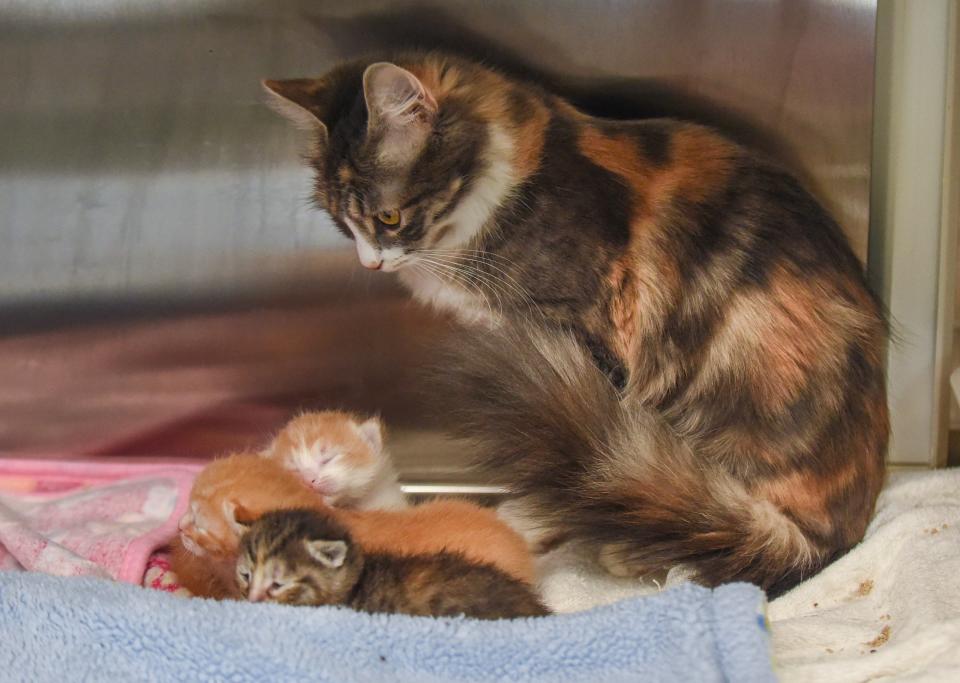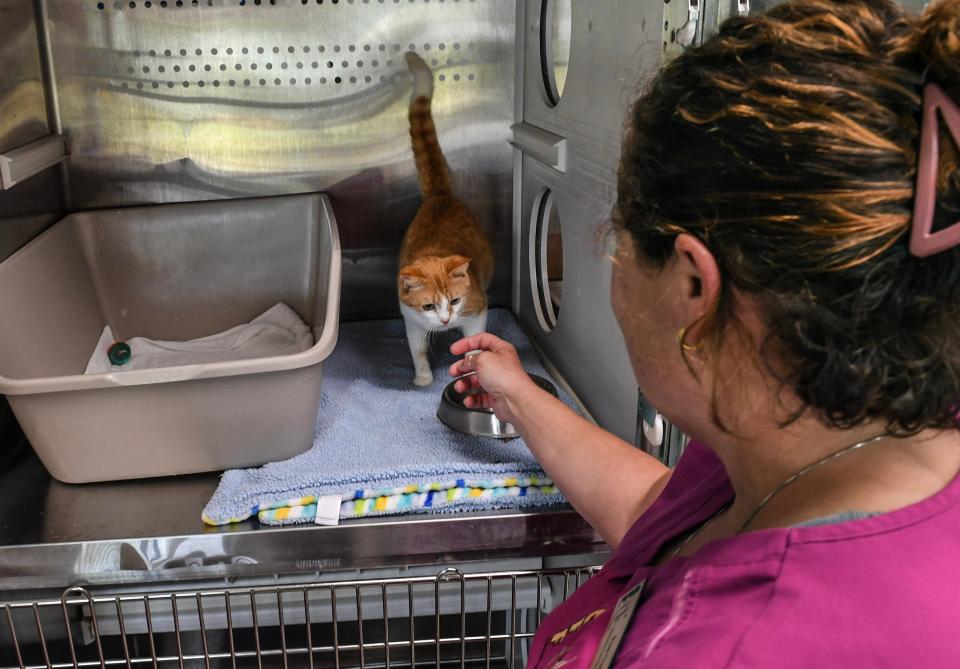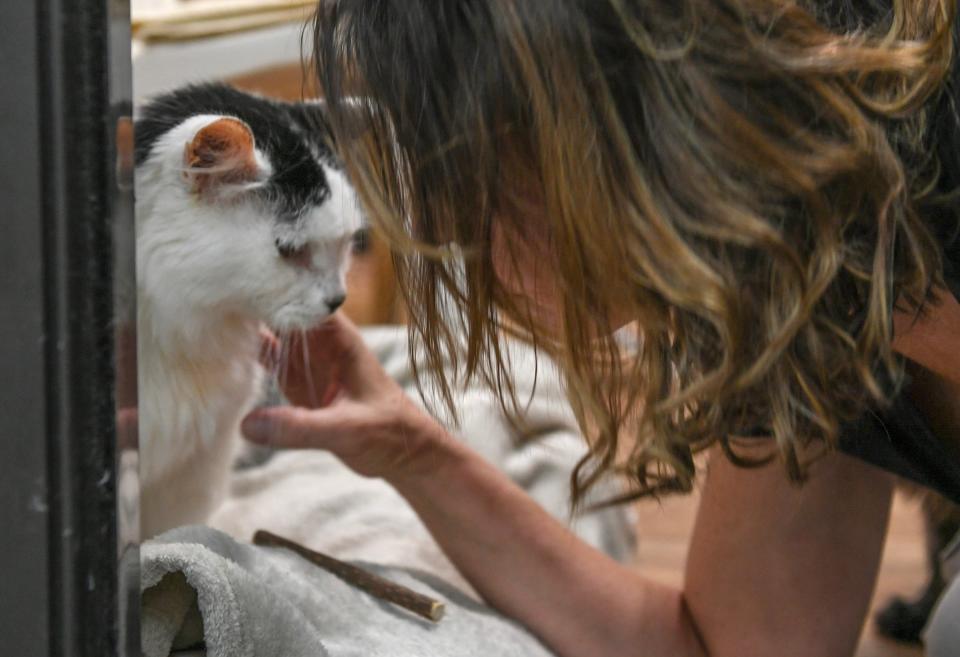Cat-astrophe: Kitten population surges as Palm City cat sanctuary staffing hits low ebb
In some respects, the property at the end of a quiet Palm City cul-de-sac isn't all that different from others you find along the Treasure Coast.
It's a gated community with a collection of tidy houses and neatly tended yards, inhabited by residents who are living their best lives in an idyllic setting.
Also, like other neighborhoods on the Treasure Coast, an influx of new neighbors is a cause for concern.
Most of the residents at 6807 SW Wedelia Terrace are unlikely to picket Martin County Commission meetings with "no growth" signs, though. As clever as they are, cats aren't known for their political activism.
'Running with the big cats'

That address is the location of Caring Fields Felines, a cat sanctuary that has been in operation since 2000. Pauline Glover, Caring Fields' executive director, describes the place as "just a little rescue operation, but we can run with the big dogs. Or big cats, however you want to put it."
Glover is being modest. The sanctuary, funded largely through donations, is far different from run-of-the-mill animal shelters. Instead of living in cages, most of the cats live in one of the 15 miniature houses scattered about the property. Their homes are equipped with beds and toys, with walls decorated by the many volunteers who assist with the operation.
The air-conditioned houses have kitchen facilities for meal preparation. Radios pipe in soothing music to keep the cats and the volunteers company.
The houses are equipped with cat doors, naturally, so the residents are free to go outside and roam fenced-in yards when the weather's nice. Some are known to congregate in trees, surveying their surroundings with typical feline indifference.
Because the layout is so different from most shelters, Caring Fields needs a lot of volunteers to keep the grounds tidy and the feline population fed and watered.
While some residents are shy, others have big personalities, like Armando, a 15-year-old who used to regularly greet visitors until he became afflicted with leukemia and had to be sequestered with other cats with the same illness.
"We called him the mayor because he was the leader of the pack," said Joanne Hamel, one of the sanctuary's volunteers.
A few with special needs live in the facility's administrative offices, where a full-time staff of seven can keep closer tabs on them. The staff includes veterinarians, who can tend to sick or injured kitties at on-site medical facilities.
A popular enclave for Florida felines

At any given time, about 150 to 160 cats live at Caring Fields. As with the animals found in more conventional shelters, many of the cats who arrive there are strays or given up by their owners for various reasons.
A large number of cats come from Okeechobee County, which has no shelter facilities.
The houses have "acclimation rooms" where new arrivals can stay behind lattice walls and doors until the other inhabitants get used to their scent. And vice versa.
"Everyone has to get along here ― and they pretty much do," Hamel said.
Caring for so many critters is a big job. To offer just one example, Caring Fields goes through about 6,000 pounds of kitty litter every five months.
While some of the older cats may never be adopted because of health challenges or other reasons, the facility claims a 100% adoption rate for kittens.
Managing the kitten population becomes especially challenging this time of year.
An explosion of kittens is coming

While cats can and do mate year-round, feline mating cycles have certain seasonal peaks and valleys.
While people talk about rabbits being extremely active breeders, cats are no slouches in this regard, either.
Cats can reach sexual maturity within a few months after they are born. Once they become sexually active, a female cat can produce multiple litters of kittens in a single year.
Pregnant cats typically give birth a little more than two months after they become pregnant. After producing a litter of kittens, a female can be ready to mate again as soon as eight weeks.
This might explain why animal control experts stress the importance of spaying and neutering pets.
Perhaps because kittens have better odds of surviving and thriving during warm weather months, one of the peak seasons for new kittens starts in April and continues throughout the late summer months.
Last year, for example, Caring Fields had about 385 kittens pass through its doors. More than 300 of them arrived during the peak spring/summer season.
Cats and snowbirds don't mix

Unfortunately, the Great Kittening (which sounds like it should be the title of a Stephen King novel) happens when the sanctuary's stockpile of volunteers hits a low ebb.
"We have a lot of volunteers and foster volunteers who are snowbirds," Hamel said. "When they leave in April, they don't come back until November. It's an issue."
The numbers fluctuate, but Caring Fields usually has a volunteer staff of around 100, most of whom are involved in feeding the cats and cleaning their houses.
However, of that total, only about a quarter are considered "core" volunteers, who are regularly at Caring Fields multiple days each week. Of those 20 to 25 core volunteers, about five migrate northward in warm weather months.
So yes, Caring Fields needs volunteers. Hamel said the basic requirements for volunteers include reliability and a willingness to get dirty and sweaty in conditions that can be hot and humid or rainy. Current volunteers range in age from 8 to 93, with some high school students earning credit for their work.
It should go without saying, but loving cats is also a prerequisite of the job.
Who knows? A stint as a feline housekeeper may be just the boost your resume needs.
To learn more about Caring Fields, call 772-463-7386 or visit the organization's website, www.cffelines.org
This column reflects the opinion of Blake Fontenay. Contact him via email at blake.fontenay@tcpalm.com or at 772-232-5424.
This article originally appeared on Treasure Coast Newspapers: Palm City kitty crisis: Feline population grows as volunteers dwindle

